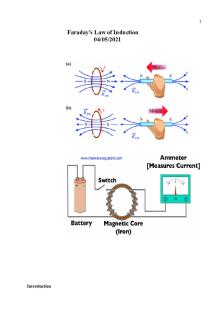Lab Report 6 Part I PDF

| Title | Lab Report 6 Part I |
|---|---|
| Course | ENVIRONMENTAL ANALYSIS |
| Institution | The University of Texas at Arlington |
| Pages | 3 |
| File Size | 122.2 KB |
| File Type | |
| Total Downloads | 63 |
| Total Views | 148 |
Summary
Lab Reporting. Professor is Dr. Srinivas Prabakar...
Description
CE 3131-002 Environmental Analysis Laboratory Spring - 2016
Laboratory Report 4 Part – I
Experiment 8: Determine the temperature and dissolved oxygen of a given lake water, tap water and synthetic water.
Submitted by Group C Instructor: Dr. Srinivas Prabakar Group Members: 1. Shannon Hobbs 2. Leopoldo Cardiel 3. Majad Hussein
Due Date: 08-1-2016 Date Submitted: 08-1-2016
Background 1
Dissolved oxygen analysis measures how much oxygen is dissolved into a water source such as rivers, lakes, ponds, and etc. Dissolved oxygen usually gets into the water through the atmosphere or the diffusion from the surrounding air. There are many factors that affect the dissolved oxygen concentration. According to Sheila Murphy on general information on dissolved oxygen, some of these factors include:
Volume and velocity of water flowing in the water body Climate/Season The type and number of organisms in the water source Altitude Dissolved or suspended solids Amount of nutrients in the water Organic Wastes
These factors or what keep the dissolved oxygen concentration levels high or low. However, what we want are minimal levels of oxygen in a water source. But for good water quality we want high levels of the concentration. According to KY Water Watch, dissolved oxygen concentrations cannot exceed 110 percent as this level of concentration can be dangerous to aquatic life. Aquatic life relies on the oxygen in the water to breathe. The high levels of dissolved oxygen cause aquatic life to suffer from gas bubble disease where the bubbles block the flow of blood through blood vessels resulting in death. The higher the dissolved oxygen concentrations, the higher the stress the aquatic life undergo leader to the gas bubble disease. However, dissolved oxygen is necessary for good water quality in the water sources. In order to maintain water quality without harming aquatic life and keeping their stress levels down, we maintain low levels of dissolved oxygen in the water. All aquatic life has a tolerance to minimal amounts of dissolved oxygen.
Definitions and Significance
Materials and Methods
Appendix: Sample
Electronic Method
Volume Method 2
Room Temp Room Temp with salt < 15 °C > 35 °C
Pressure (mm Hs)
Temp (°C)
DO (mg/L)
747 748 745 741 744 750 742 740
23.24 23.32 23.27 23.28 14.65 15.23 39.28 39.15
7.960 9.230 10.20 10.31 10.17 10.08 9.580 9.790
References: http://www.state.ky.us/nrepc/water/wcpdo.htm http://bcn.boulder.co.us/basin/data/COBWQ/info/DO.html
3
Volume of Na2S2O3 Trial 1 Trial 2 7.5
7.0
7.0
7.0
8.9
9.2
3.6
4.4...
Similar Free PDFs

Lab Report 6 Part I
- 3 Pages

Lab 6 - Lab Report
- 6 Pages

Lab 7 Report Part 1
- 3 Pages

Calorimetry Part 2 Lab Report
- 6 Pages

Lab report Biofuels Part 1
- 4 Pages

Lab Report 5 Part 1
- 3 Pages

Phys lab 6 - Lab report 6
- 13 Pages

Lab Report Nr 6 - lab 6
- 7 Pages

Orgo Lab 6 - Lab report
- 6 Pages

Physics Lab Report #6
- 4 Pages

Bio161 Lab Report #6
- 1 Pages

Experiment 6 Lab Report
- 5 Pages

Experiment 6 - lab report
- 6 Pages

Lab report 6 assignment
- 4 Pages

LAB 6 - report
- 2 Pages

Experiment 6 Lab Report
- 19 Pages
Popular Institutions
- Tinajero National High School - Annex
- Politeknik Caltex Riau
- Yokohama City University
- SGT University
- University of Al-Qadisiyah
- Divine Word College of Vigan
- Techniek College Rotterdam
- Universidade de Santiago
- Universiti Teknologi MARA Cawangan Johor Kampus Pasir Gudang
- Poltekkes Kemenkes Yogyakarta
- Baguio City National High School
- Colegio san marcos
- preparatoria uno
- Centro de Bachillerato Tecnológico Industrial y de Servicios No. 107
- Dalian Maritime University
- Quang Trung Secondary School
- Colegio Tecnológico en Informática
- Corporación Regional de Educación Superior
- Grupo CEDVA
- Dar Al Uloom University
- Centro de Estudios Preuniversitarios de la Universidad Nacional de Ingeniería
- 上智大学
- Aakash International School, Nuna Majara
- San Felipe Neri Catholic School
- Kang Chiao International School - New Taipei City
- Misamis Occidental National High School
- Institución Educativa Escuela Normal Juan Ladrilleros
- Kolehiyo ng Pantukan
- Batanes State College
- Instituto Continental
- Sekolah Menengah Kejuruan Kesehatan Kaltara (Tarakan)
- Colegio de La Inmaculada Concepcion - Cebu